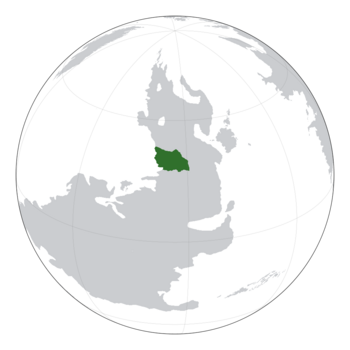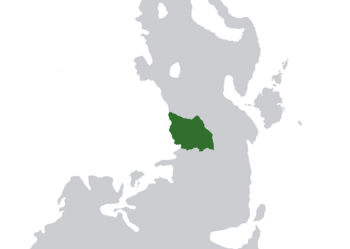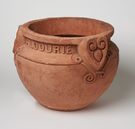Hapatmitas
Commonwealth of Hapatmitas Co-fhlaitheis Hapatmitas | |
|---|---|
Motto: Adhartas, dìlseachd, aonachd. "Progress, loyalty, unity." | |
Location of Hapatmitas (dark green) | |
| Capital | Donideann |
| Largest city | Sturgeon |
| Official languages | Eusazy |
| Ethnic groups (2022) | 89.2% Hapat 2.6% Paleocacherian 8.2% Other |
| Religion (2022) | 56.8% Christianity 28.7% Unaffiliated 6.1% Clovity 8.4% Other |
| Demonym(s) | Hapatmitasian |
| Government | Devolved unitary semi-presidential directorial republic |
| Ewan Thorcaill | |
| Nicola Ferguson Stewart Salmond | |
| Cormac Gilchrist | |
| Legislature | National Assembly |
| Formation | |
• Mass migration from Paleocacher | c. 1200 AD |
• Consolidated into the Principality of Hapatmitas | 4 September 1691 |
• Absolute monarchy proclaimed | TBD |
• Constitutional monarchy installed | TBD |
| TBD | |
| TBD | |
| 1 July 1972 | |
| Area | |
• Total | 274,159 sq mi (710,070 km2) (41st) |
| Population | |
• 2020 census | |
• Density | 142/sq mi (54.8/km2) |
| GDP (nominal) | 2023 estimate |
• Total | ₵1.36 trillion (18th) |
• Per capita | ₵34,936 (15th) |
| HDI (2021) | very high · 11th |
| Currency | Hapatmitasian pìoban (₴) (HPB) |
| Time zone | AMT+12 (Donideann Standard Time) |
| Driving side | right |
| Calling code | +403 |
Hapatmitas (Eusazy: ![]() xapʌtmi:tæːz), officially the Commonwealth of Hapatmitas (Eusazy: Co-fhlaitheis Hapatmitas), is a country located in northern Ostlandet. The country is bordered by Paleocacher to the north and the Acernis Ocean to the west. With an area that spans 274,159 sq mi (710,070 km2) divided into 15 provinces, Hapatmitas is the 41st largest country in the world. The country has a population of around 38.9 million which mainly resides in the densely-populated Peannish. Its capital city is Donideann and its most populous city is Sturgeon, housing nearly 9 million residents. Other major cities including Peairtchu, Boghmor, Crubagath, Inchmarlo, and Banchar.
xapʌtmi:tæːz), officially the Commonwealth of Hapatmitas (Eusazy: Co-fhlaitheis Hapatmitas), is a country located in northern Ostlandet. The country is bordered by Paleocacher to the north and the Acernis Ocean to the west. With an area that spans 274,159 sq mi (710,070 km2) divided into 15 provinces, Hapatmitas is the 41st largest country in the world. The country has a population of around 38.9 million which mainly resides in the densely-populated Peannish. Its capital city is Donideann and its most populous city is Sturgeon, housing nearly 9 million residents. Other major cities including Peairtchu, Boghmor, Crubagath, Inchmarlo, and Banchar.
The area now identified as Hapatmitas has been inhabited since the year 46 AD. During the 9th century, the first Eusazy-speaking ethnic groups originating from Paleocacher, including the early Hapats, undertook migrations to the region. These ethnic communities were organized into medieval states, which contended for fertile and prosperous land in the river regions. This period of contention, spanning four centuries in Hapatmitasian history, is referred to as the Four Hundred Years. The economies of many of these kingdoms were predominantly based on agriculture and fishing, activities that not only sustained local populations but also facilitated trade through the exchange of goods. Alliances were formed, contributing to the intricate web of regional trade networks. In the year 1624, following significant mobilization efforts in preceding years, the Hapats initiated hostilities against western alliances, ultimately achieving success in the conquest of its enemies. This conquest, finalized in 1686, led to the consolidation of these territories into the Principality of Hapatmitas in 1691.
In the early 19th century, a surge of ultraroyalist factions emerged within the government of Hapatmitas, culminating in the proclamation of an absolute monarchy following the abdication of the last Prince of Hapatmitas. This period witnessed the Kingdom of Hapatmitas expanding its territorial boundaries to the south and fostering a robust trade economy along the Ostlandetian coast of the Acernis Ocean. In 1889, James IV abolished the absolute monarchy in favour of democracy, relegating himself to a ceremonial monarch. The ensuing Hapatmitasian Federation succeeded the trading empire, and James' successors assumed ceremonial roles. However, despite the popularity of the new monarchy in the 19th century, the downfall of monarchism occurred in the 20th century with the combined efforts of surging republicanism and mass propaganda. A democratic constitution was ratified and a republic was established in 1939. The transition was met with resistance, however, from numerous traditional political factions, sparking hundreds of civil conflicts in the ensuing years. In the fall of 1946, a significant turning point occurred with the outbreak of a civil war between the conservative loyalist and liberal progressive factions. The civil war ended in 1950 under a loyalist victory, solidifying the establishment of a predominantly conservative regime. The loyalist regime persisted until 1972 when the Commonwealth was proclaimed on 4 August.
Over forty years, Hapatmitas unwaveringly advanced its economy, military, technology, and government. The pharmaceutical and banking sectors grew tremendously, expanding the Hapatmitasian influence across the Acernis Ocean and Ostlandet. Hapatmitasian infrastructure was also mass-developed across Peannish and the highlands region, connecting the country's cities' network. The military invested in new military technology and reorganised the command structure which refortified the Hapatmitasian military response command and order of field defence priority. Hapatmitas also deeply expanded its foreign relations, building dozens of embassies across Terraconserva. The legislature also went under major restructuring changes by a total of eight times as of November 2023, contributing to the country's high GDI score.
Hapatmitas is a member of the Ostlandet Union, Prosperity of 7, and Terraconserva Council of Nations. The country currently follows an active foreign policy while restraining itself from directly intervening in major conflicts. More recently, in the military intervention in Shaoyu, Hapatmitas supported the Ostlandet Union task force for intervention with material and diplomatic means. The country has historically been neutral in international conflicts but has advanced towards closer foreign relations after its civil war. The country also has a strict system for education, healthcare, and workers' rights in part due to the post-authoritarian growth. As of 2023, Hapatmitas' diverse economy is currently the 18th largest by nominal gross domestic product (GDP) in Terraconserva; the country also has a very high Human Development Index; and has a score of 8.83 in the Global Democracy Index, making it the most democratic country on Ostlandet and one of the most democratic countries in the world.
Contents
- 1 Etymology
- 2 History
- 2.1 Pre-settlement civilizations and settlement (to c. 1200)
- 2.2 Four Hundred Years (c. 1200–1686)
- 2.3 Principality era (1691–1822)
- 2.4 Imperialist period (1820–1889)
- 2.5 New Monarchy period (1889–1939)
- 2.6 First Republican period (1939–1950)
- 2.7 Hapatmitasian Civil War (1946–1950)
- 2.8 Second Republican period (1950–1972)
- 2.9 Modern Hapatmitas (1972–present)
- 3 Geography
- 4 Government and politics
- 5 Economy
- 6 Demographics
- 7 Culture
- 8 See also
- 9 Notes
Etymology
The name Hapatmitas' earliest mention was in 891 AD when the tribal nation was named for territorial sovereignty. The Old Eusazy word for "land" was roughly translated into mighta; the Hapat dialect of old Eusazy sounded like mita however, hence the latter's usage in Hapat Old Eusazy. The combination of the ethnic group's name and the word turned into Hapatmitas. In tribal Hapatmitas, many tribesmen were Clovic and wrote several meanings of the name; most suggested that the god of nature blessed the Hapats for great harvest seasons, rain, and sunlight, hence the name "mighta" to represent the agricultural might of Hapatmitas. Ultimately, leading up to the 16th century, these meanings were eventually lost following the transition towards New Eusazy and Christianity. It was only in 1928 that archaeologists found these divinations inscribed onto stone tablets in the Monadhruadh National Park.
History
Pre-settlement civilizations and settlement (to c. 1200)
Historians and archaeologists believe that Hapatmitas has been inhabited for nearly 2,000 years. As part of the last few minor migrations from Ecros to Ostlandet, settlers usually arrived on large boats. The first tribal civilizations started growing in c. 120 AD. Mass plantations of wheat, barley, and various root tuber vegetables across the Rinnfriu and Forth rivers were created which grew the northern and southern regions of Hapatmitas. These settlements were often led by a group of people with expertise in various occupations: farmers, ironsmiths, and builders. Farmers comprised of majority of these populations, often followed by builders and then ironsmiths. Other smaller groups of settlers moved inland towards the Hapatmitasian highlands and farmed using hill terrace methods that were effective in utilizing the mountain groundwater. Many civilizations also advanced in farming technology, including the plow first introduced to Hapatmitasian civilizations in 198 AD.
Infighting between the tribes started around 350 AD. Their farms became intertwined with one another due to unexpected growth and, as a result, farmers began fighting each other over the amount of land each one owned. Tribal leaders often refused to negotiate and went to war, devastating the food sources of the river civilizations and ending many tribes. In other cases, tribes formed temporary alliances to attack a common enemy. These alliances were the only means of cooperation and peace during this time. Many other skirmishes alike would follow through the rest of the prehistoric era of Hapatmitas.
The first major civilization in Hapatmitas was the Celiac Empire. Celia emerged around the 5th century AD in present-day Gaillimhe. The Celiacs were renowned for being nomadic, having a culture that strongly relied on the use of horses. As skillful farmers and merchants joined together at the helm, the civilization became largely economical. Celiacs also rapidly militarized and used their military power to invade surrounding neighbors. The civilization relied on local governors and shared farming communes to protect its territory. The empire, at its height, expanded as far as past the highlands region. The civilization collapsed in c. 900 AD after a series of northern raids by Lithorics, which succeeded the Celiac civilization, combined with a declining military and economy.
After successfully invading Celia, Lithor began enforcing its rule over its predecessor's territory. The remaining Celiacs were put into slavery by Lithoric nobles and were often put to work building massive statues worshipping Lithoric kings. This process of suppression eventually wiped away the Celiac ethnic group. Lithor was radical in its military, often incorporating raids as "the kings' will." The promotion of literacy was also suppressed and those capable of expressing art were forced to create large hieroglyphics of pagan gods and past Lithoric kings. The kingdom fell at the end of the 11th century because of its instability.
At the start of the 12th century, the first migrations from Paleocacher to Hapatmitas began. Emigrants that settled in modern-day Chiarain often migrated on foot while others migrated by horse and wagon. The Hapats settled near modern-day Banchar. On the Rinnfriu River, emigrants began even larger plantations than those during the prehistoric civilizations, even setting up villages that formed unofficial cantons. These cantons often joined together to form a confederal association dependent on the river. Over the century, the confederal associations across Hapatmitas began to transition into caste kingdoms. Kings were often elected to direct the direction of the state's food supply, economy, and defense. This system was customized to each association, with some cultural customs sometimes also being installed into government. However, the kings’ decrees often interfered with each other which unleashed many bloody wars. By the beginning of the 13th century, what historians coin as the Four Hundred Years began.
Four Hundred Years (c. 1200–1686)
The Four Hundred Years severely deteriorated many kingdoms' economic and political state. Because the caste system was extremely important, opposing armies often attempted to strike at large plantations and farmlands first to confiscate serfs and other lower-class laborers. Raids also often focused on the destabilisation of a local region of a kingdom before capitulation. In 1268, a major war between the Hapat kingdom and the Pontinrees broke out. The conflict attained historical significance as the military campaigns were marked by the widespread deprivation of lower-class laborers from both belligerents, with approximately 30,000 serfs dead at the end of the war in 1272.
(TBC)
Principality era (1691–1822)
Imperialist period (1820–1889)
New Monarchy period (1889–1939)
First Republican period (1939–1950)
Hapatmitasian Civil War (1946–1950)
Second Republican period (1950–1972)
Modern Hapatmitas (1972–present)
Geography
Climate
Environment
Urbanization
Government and politics
Hapatmitas is a unitary parliamentary directorial republic with regionalised administration. National legislative power is vested into the unicameral National Assembly. Members of the National Assembly are elected through direct elections using the mixed-member proportional representation system. The Hapatmitasian political system operates under a framework laid out in the 1972 constitution. Constitutional amendments generally require a two-thirds majority of the legislature; the fundamental principles of the constitution are inscribed permanently. In particular, the MMP representation electoral system was a recent amendment to better suffix a proportionate representation of the growing Hapatmitasian population in the national legislature.
Under the semi-presidential directorial system, the head of state is collectively the Presidency of Hapatmitas, currently Ewan Thorcaill, Nicola Ferguson, and Stewart Salmond. The Presidency is elected by universal adult suffrage for a four-year term. The First Minister, currently Cormac Gilchrist, is the head of government, appointed by the Presidency; the First Minister is also concurrently the leader of the largest party in the National Assembly and is responsible for administering the session's business. The Presidency has the power to dissolve the National Assembly or circumvent it by submitting referendums directly to the people. The Presidency is also vested with the responsibilities of appointing judges and civil servants, negotiating and ratifying international agreements, as well as serving as commander-in-chief of the armed forces; the latter duty is only active during wartime. The Prime Minister administers domestic and public policy.
Historically, conservative factions were the primarily dominant political force in Hapatmitas, embodied by the New Republic Party which was the reigning and most important party of the Second Republic. However, after the abolition of the Second Republic in 1972, politics in Hapatmitas were dominated by three politically opposing groups - moderate conservatives, liberal and social democrats, and other minority parties. Today, Hapatmitasian politics are dominated by two political rivals - the National Coalition Party and the Social Democrats.
Administrative divisions
Hapatmitas, with a total area of 274,159 square miles (710,070 square kilometres) is divided into eight regions (Eusazy: roinnean). The administrative divisions are organised into five different levels - the central government, first-level divisions, second-level divisions, third-level divisions, and fourth-level divisions. Regions are first-level divisions; provinces (mòr-roinnean) and municipalities (bailtean-mòra) are second-level divisions; counties (siorrachdan) are third-level divisions; and townships (bailtean) are fourth-level divisions. Public and private agencies often refer to regions for statistical use.
The current local government system was created on 10 January 1997 to merge the provinces to form a regionalised unitary state in Hapatmitas. Before 1997, counties with large populations often were given a higher level than rural counties; as a result urban counties were given more financial sustainability. After the system was established, equal power leveling was created to optimise "regional potential." Today, regions are governed by directly-elected regional councils every five years, with a distinct possibility of recall referendum and elections occurring more as a result of the term length; the most recent Hapatmitasian local elections were held on DATE. Public agencies, law enforcement, and other local institutions often use county and municipal boundaries to administer their duties.
Foreign relations
Hapatmitas is currently a member of the Ostlandet Union and the Terraconserva Council of Nations. Because of its historic neutrality, Hapatmitas has good relations with most countries across Terraconserva, with closer cultural ties to Gallaetic countries such as Paleocacher and its historic influence from Montcrabe. It also possesses membership in the P7 which has promoted deep economic ties with countries in other continents.
Because of its positive relations, Hapatmitas is a trading partner to several economically influential countries. It has often performed joint military operations, economic initiatives, and other forms of supranational activities that have grown the country. Joint economic ventures in corporations such as Robasdan has developed the robust Hapatmitasian economy.
Military

Hapatmitas' military (Feachdan Armaichte Hapatmitasian; FAH) is organised into the Arm (Army and ground special forces), Cabhlach (Navy), Feachd Adhair (Air Force), Geàrd Nàiseanta (National Guard), and the Maoir-chladaich (Coast Guard). These service branches formally serve as the collective armed forces of Hapatmitas. Since 1996, the expenditure for the military has always been the third-highest in the national budget because of the neutral stance on foreign policy taken by the government. After the military conflict regarding Akvatika (Shaoyu) Island in September 2023, the government has begun auditing the military expenditure for further increases by the next fiscal year.
As of December 2023, the FAH has a strength of 53,000 active soldiers and 340,000 reservists. Reservists are available to the armed forces and participate in defence exercises and deployments abroad. Since 2000, the armed forces has maintained voluntary service. Since 1996, women have been granted the right to serve in all functions of military service without restriction; military ethics codes were also updated in regards to religion and gender. Hapatmitas, despite its industrial state, does not produce any major domestic arms and hence imports a lot of arms.
During peacetime, the role of commander-in-chief is usually vacant. As a result, the FAH is jointly commanded by the Minister of Defence and the Chief of the Defence Staff during peacetime. In the Constitution of Hapatmitas, the role of the FAH during wartime is defined to be defensive which includes "the defence of internal security, aligned interests, and the protection of Hapatmitasian borders and sovereignty." A 2004 ruling by the Constitutional Court also deemed the FAH responsible for "crisis reaction, conflict prevention, and resolution of disputes." Despite the defensive doctrine, the armed forces still maintain a neutral stance at home and does not keep any foreign peacekeeping soldiers abroad as of 2023.
Security, law enforcement and emergency services
Law enforcement in Hapatmitas is performed by multiple agencies. All law enforcement agencies are nationally administered and regulated by the Ministry of the Interior. Municipalities possess their own police and fire department but do not have crime investigatory and specialised law enforcement agencies. This is opposed to regions, which possess a united police agency for all other cities, counties, and townships. Specialised law enforcement agencies, such as the Hapatmitasian Border Services Agency, are still administrated and regulated by the Ministry of the Interior. Private security firms are allowed to operate in Hapatmitas but they do not have legal authority or jurisdiction to arrest or detain suspected individuals. Regional and municipal police often perform joint operations or patrols in urban and suburban areas.
Internal security is currently jointly managed by the Ministry of the Interior (Ministrealachd an Taobh a-staigh; MTA), the National Intelligence Service (Seirbheis Fiosrachaidh Nàiseanta; SFN), and the Military Intelligence Directorate (Buidheann-stiùiridh Fiosrachaidh Armailteach; BSFA). The MTA is responsible for administering lower agencies involved with civil and minor domestic security threats; the SFN is the chief domestic agency responsible for identifying domestic threats to national security and safeguarding national security by task forces; the BSFA is the foreign agency instrumental in gathering intelligence abroad concerning internal security and investigating foreign breaches involving Hapatmitasian national security.
Emergency services in Hapatmitas consist of emergency medical services, search and rescue units, and fire services. Emergency medical services are generally operated by municipalities and other types of cities but are all part of the regional agency responsible for emergency medical response. Search and rescue units in Hapatmitas are diversified between special units of a local police force and/or search-and-rescue units deriving from the Hapatmitasian Armed Forces. Fire services are administrated by grouped provincial departments, especially in densely populated regions such as Gaillimhe; in larger provinces such as those in Paislig agus Chluaidh possess their department but are sometimes provided less funding than urban departments.
Economy
Overview
Agriculture and mining
Manufacturing
Technology and science
Infrastructure and transport
Demographics
Ethnicities
Languages
Religion
Education
Health
Culture
Hapat culture has been strongly associated with the faith in Christianity. In part due to the Montcrabin Catholic missionaries that arrived in Hapatmitas during the 14th century, the culture of Hapatmitas has been largely surrounded around God and the belief in God's intuition in granting great harvests and prosperity to professions. The belief in individualism in Hapatmitas advanced the population's performance in literacy and art. However, despite individualistic ideals, Hapats often encourage each other to participate in governance and altruism to avoid strife with God. These combined faiths created a society based on merit and performance rather than aristocracy and hierarchy. Hapats in the faith of Clovity empathized with the Christian ideals and incorporated these beliefs as well. In a 2016 government survey, 82% of the Hapat population believed in cooperative ideals of individualism and collectivism.
The expression of culture expanded upon the start of the Principality era. Festivals, art, and architecture became popular during peacetime. The art of scriptures also became enrooted into Hapat culture, most notably in calligraphy and records. Hapats had a closer expertise, however, in physical refinery which included the occupations of blacksmiths, hunters, miners, and farmers. Architecture in Hapatmitas is strongly influenced by prehistoric civilizations as well as from foreign countries, such as Montcrabe. Linguistically, Eusazy is the commonplace language in Hapatmitas because of its official status. However, other languages including LANGUAGE 1 and LANGUAGE 2 are used by minorities in border regions of the country.
Television and media
Music
Hapat music is a significant aspect of the nation's culture, incorporating both traditional and modern influences. The most famous traditional Hapat instrument is the Gaidhealtachd bagpipe, a woodwind instrument consisting of three drones and a melody pipe fed continuously by a reservoir of air in a bag. As opposed to (Paleocacherian bagpipe), the Gaidhealtachd bagpipe's parts, such as the chanter reed and bag, are made out of native Hapatmitasian materials. In military bands, the bagpipe is usually played along with various types of percussion and brass instruments, with players showcasing traditional Hapat dresses. Pipe music is also featured in holiday celebrations, funerals, weddings, military parades, and other events. During the monarchist era of Hapatmitas, bagpipes were most commonly associated with the presence of an emperor, especially at their coronations. In some military regiments, a pipe band may solely consist of bagpipe players. While the bagpipe is extremely popular, other brass instruments are also equally played as often including the trumpet and the tuba.
Several domestic and international award shows and festivals recognise musical talent in Hapatmitas. Some of the domestic shows and festivals include the Connection Festival Sturgeon, Hapat Music Awards, Grand Music of Hapatmitas, and the All-Hapatmitas Bagpipe Competition. Additionally, the promotion of string arts in Hapatmitas has excessively grown since a 2004 government initiative. Today, the International MacRaghnaill Competition is renowned for hosting quadrennial classical music competitions for ages between 16 and 32 years old - it is considered one of the easiest yet rigorous ways to earn a scholarship in Hapatmitas.
Architecture
Sports
Public holidays
Currently, there are 13 national public holidays in Hapatmitas. Some holidays are referred to as bank holidays, which most government agencies and banks close on as well. The government requires employers to function their business as a non-working day or to pay workers overtime if they work on that holiday. The government recognizes other unofficial holidays but does not recognize them as non-working days. Regionally, provincial holidays of culture or history may be declared with recognition if they pass the provincial legislature. For instance, three other bank holidays are recognized for the autumn, winter, and springtime seasons but vary by province; the only bank holidays every province observes on the same day are on 4 June, 4 August, and 19 August.

The thirteen national public holidays are:
| Date(s) observed | English name | Eusazy name | Remarks |
|---|---|---|---|
| 1 January | New Year's Day | Là na Bliadhn' Ùire | Celebrates the start of a new calendar year |
| 2 January | 2 January Day | Dàrna latha den Fhaoilleach | Official bank holiday; created in 2006 to extend the New Year's holiday |
| moveable | Good Friday | Dihaoine na Càisge | Commemorates of the crucifixion of Jesus Christ |
| moveable | Easter Sunday | Didòmhnaich na Càisge | Commemorates of the resurrection of Jesus Christ from the dead |
| 1 May | Labour Day | Là Làbarach | Celebrates the achievements of workers |
| 4 June | Summer Bank Holiday | Ceathramh latha den Ògmhios | An official national bank holiday for the Summer season |
| 1 July | National Day | Latha Nàiseanta | Celebrates the anniversary of the proclamation of the Commonwealth |
| 6 July | Civil Victory Day | Latha Buaidh Shìobhalta | Celebrates the anniversary of the end of the Hapatmitasian Civil War |
| 4 August | Opening Day | Latha Fosglaidh | An official national bank holiday; concurrent with the opening of Parliament and observed only every four years |
| 19 August | Remembrance Day | Latha Cuimhneachaidh | An official national bank holiday; commemorates the achievements of fallen soldiers |
| 4 September | Foundation Day | Latha Bunait | Celebrates the anniversary of the foundation of the first consolidated Hapatmitasian state |
| 30 November | Saint Duncan's Day | Latha Naomh Donnachadh | The feast day of Saint Duncan, patron saint of Hapatmitas |
| 25 December | Christmas Day | Latha na Nollaige | Commemorates the birth of Jesus Christ |








